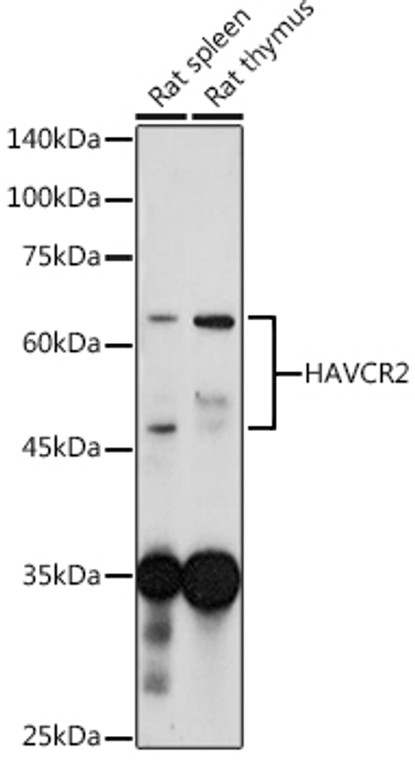| Host: |
Rabbit |
| Applications: |
WB |
| Reactivity: |
Human/Mouse/Rat |
| Note: |
STRICTLY FOR FURTHER SCIENTIFIC RESEARCH USE ONLY (RUO). MUST NOT TO BE USED IN DIAGNOSTIC OR THERAPEUTIC APPLICATIONS. |
| Short Description: |
Rabbit polyclonal antibody anti-HAVCR2 (20-193) is suitable for use in Western Blot research applications. |
| Clonality: |
Polyclonal |
| Conjugation: |
Unconjugated |
| Isotype: |
IgG |
| Formulation: |
PBS with 0.05% Proclin300, 50% Glycerol, pH7.3. |
| Purification: |
Affinity purification |
| Dilution Range: |
WB 1:500-1:1000 |
| Storage Instruction: |
Store at-20°C for up to 1 year from the date of receipt, and avoid repeat freeze-thaw cycles. |
| Gene Symbol: |
Havcr2 |
| Gene ID: |
171285 |
| Uniprot ID: |
HAVR2_MOUSE |
| Immunogen Region: |
20-193 |
| Immunogen: |
Recombinant fusion protein containing a sequence corresponding to amino acids 20-193 of mouse TIM-3/HAVCR2 (NP_599011.2). |
| Immunogen Sequence: |
RSLENAYVFEVGKNAYLPCS YTLSTPGALVPMCWGKGFCP WSQCTNELLRTDERNVTYQK SSRYQLKGDLNKGDVSLIIK NVTLDDHGTYCCRIQFPGLM NDKKLELKLDIKAAKVTPAQ TAHGDSTTASPRTLTTERNG SETQTLVTLHNNNGTKISTW ADEIKDSGETIRTA |
| Tissue Specificity | Expressed in T-helper type 1 lymphocytes. Not expressed by naive T-cells but up-regulated as they differentiate into T-helper-1 cells. Also expressed by differentiated type 1 CD8+ cytotoxic T-cells. Expressed on peritoneal exudate macrophages, monocytes, and splenic dendritic cells (DCs). Expression on natural killer (NK) cells is inversely associated with IFN-gamma production during the initial 24 hours of LPS-induced endotoxic shock. Expressed on mast cells. |
| Post Translational Modifications | Phosphorylated on tyrosine residues.modestly increased after TCR/CD28 stimulation. Can be phosphorylated in the cytoplasmatic domain by FYN. Phosphorylation at Tyr-256 is increased by stimulation with ligand LGALS9. N-glycosylated. |
| Function | Cell surface receptor implicated in modulating innate and adaptive immune responses. Generally accepted to have an inhibiting function. Reports on stimulating functions suggest that the activity may be influenced by the cellular context and/or the respective ligand. Regulates macrophage activation. Inhibits T-helper type 1 lymphocyte (Th1)-mediated auto- and alloimmune responses and promotes immunological tolerance. In CD8+ cells attenuates TCR-induced signaling, specifically by blocking NF-kappaB and NFAT promoter activities resulting in the loss of IL-2 secretion. The function may implicate its association with LCK proposed to impair phosphorylation of TCR subunits. In contrast, shown to activate TCR-induced signaling in T-cells probably implicating ZAP70, LCP2, LCK and FYN. Expressed on Treg cells can inhibit Th17 cell responses. Receptor for LGALS9. Binding to LGALS9 is believed to result in suppression of T-cell responses.the resulting apoptosis of antigen-specific cells may implicate HAVCR2 phosphorylation and disruption of its association with BAG6. Binding to LGALS9 is proposed to be involved in innate immune response to intracellular pathogens. Expressed on Th1 cells interacts with LGALS9 expressed on Mycobacterium tuberculosis-infected macrophages to stimulate antibactericidal activity including IL-1 beta secretion and to restrict intracellular bacterial growth. However, the function as receptor for LGALS9 has been challenged. Also reported to enhance CD8+ T-cell responses to an acute infection such as by Listeria monocytogenes. Receptor for phosphatidylserine (PtSer).PtSer-binding is calcium-dependent. May recognize PtSer on apoptotic cells leading to their phagocytosis. Mediates the engulfment of apoptotic cells by dendritic cells. Expressed on T-cells, promotes conjugation but not engulfment of apoptotic cells. Expressed on dendritic cells (DCs) positively regulates innate immune response and in synergy with Toll-like receptors promotes secretion of TNF-alpha. In tumor-imfiltrating DCs suppresses nucleic acid-mediated innate immune repsonse by interaction with HMGB1 and interfering with nucleic acid-sensing and trafficking of nucleid acids to endosomes. Can enhance mast cell production of Th2 cytokines Il-4, IL-6 and IL-13. Expressed on natural killer (NK) cells acts as a coreceptor to enhance IFN-gamma production in response to LGALS9. In contrast, shown to suppress NK cell-mediated cytotoxicity. Negatively regulates NK cell function in LPS-induced endotoxic shock. |
| Protein Name | Hepatitis A Virus Cellular Receptor 2 HomologHavcr-2T-Cell Immunoglobulin And Mucin Domain-Containing Protein 3Timd-3T-Cell Immunoglobulin Mucin Receptor 3Tim-3T-Cell Membrane Protein 3Cd Antigen Cd366 |
| Cellular Localisation | Isoform 1: MembraneSingle-Pass Type I Membrane ProteinCell JunctionLocalizes To The Immunological Synapse Between Cd8+ T-Cells And Target CellsIsoform 2: Secreted |
| Alternative Antibody Names | Anti-Hepatitis A Virus Cellular Receptor 2 Homolog antibodyAnti-Havcr-2 antibodyAnti-T-Cell Immunoglobulin And Mucin Domain-Containing Protein 3 antibodyAnti-Timd-3 antibodyAnti-T-Cell Immunoglobulin Mucin Receptor 3 antibodyAnti-Tim-3 antibodyAnti-T-Cell Membrane Protein 3 antibodyAnti-Cd Antigen Cd366 antibodyAnti-Havcr2 antibodyAnti-Tim3 antibodyAnti-Timd3 antibody |
Information sourced from Uniprot.org
12 months for antibodies. 6 months for ELISA Kits. Please see website T&Cs for further guidance








